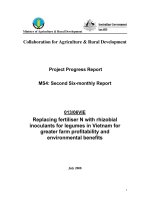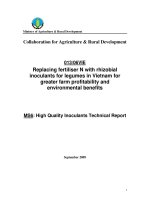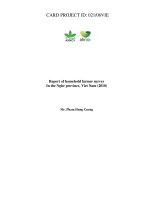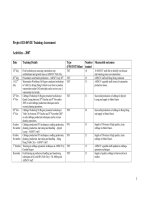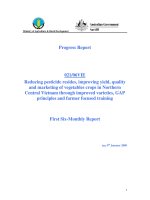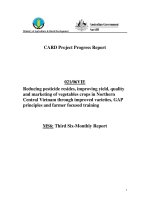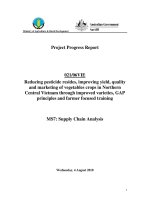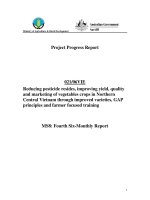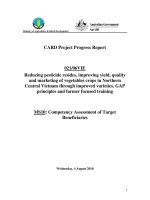Báo cáo khoa học nông nghiệp " Protecting productivity, incomes and trade through improved health surveillance of Vietnam’s plantations - MILESTONE 4 REPORT " pdf
Bạn đang xem bản rút gọn của tài liệu. Xem và tải ngay bản đầy đủ của tài liệu tại đây (2.32 MB, 48 trang )
Ministry of Agriculture & Rural Development
023/07VIE
Protecting productivity, incomes and trade through
improved health surveillance of Vietnam’s plantations
MILESTONE 4 REPORT
Date: 5 December 2008
1
Table of Contents
1. Institute Information ____________________________________________________ 1
2. Project Abstract________________________________________________________ 2
3. Executive Summary ____________________________________________________ 2
4. Introduction & Background ______________________________________________ 2
5. Progress to Date _______________________________________________________ 4
5.1 Implementation Highlights _____________________________________________ 4
5.2 Smallholder Benefits__________________________________________________ 5
5.3 Capacity Building ____________________________________________________ 5
5.4 Publicity ___________________________________________________________ 5
5.5 Project Management __________________________________________________ 5
6. Report on Cross-Cutting Issues ___________________________________________ 5
6.1 Environment ________________________________________________________ 5
6.2 Gender and Social Issues ______________________________________________ 5
7. Implementation & Sustainability Issues _____________________________________ 5
7.1 Issues and Constraints_________________________________________________ 5
7.2 Options ____________________________________________________________ 5
7.3 Sustainability________________________________________________________ 6
8. Next Critical Steps _____________________________________________________ 6
9. Conclusion ___________________________________________________________ 6
10. Statuatory Declaration ________________________________________________ 6
2
Institute Information
Project Name
Protecting productivity, incomes and trade through improved health
surveillance of Vietnam’s plantations
Vietnamese Institution
Forest Protection Research Division, Forest Science Institute of
Vietnam
Vietnamese Project Team
Leader
Dr Pham Quang Thu
Australian Organisation
Department of Agriculture, Fisheries and Forestry, Office of the Chief
Plant Protection Officer
Australian Personnel
Dr Ian Naumann
Date commenced
March 2008
Completion date (original)
June 2010
Completion date (revised)
Feb 2010
Reporting period
8 months to November 2008
Contact Officer(s)
In Australia: Team Leader
Name:
Dr Ian Naumann
Telephone:
+61 2 6272 3442
Position:
Director SPS Capacity Building
Program
Fax:
+61 2 6272 5835
Organisation
Department of Agriculture,
Fisheries and Forestry
Office of the Chief Plant
Protection Officer
Email:
In Australia: Administrative contact
Name:
Ms Wendy Lee
Telephone:
+61 2 6272 3670
Position:
Program Coordinator SPS
Capacity Building Program
Fax:
+61 2 6272 5835
Organisation
Department of Agriculture,
Fisheries and Forestry
Office of the Chief Plant
Protection Officer
Email:
In Vietnam
Name:
Ass. Pro. Dr. Pham Quang Thu
Telephone:
84 4 836 2376
Position:
Head of Forest Protection Research
Division
Fax:
84 4 838 9722
Organisation
Forest Protection Research
Division, Forest Science Institute
of Vietnam (FSIV)
Email:
1
Project Abstract
The rapid expansion of Vietnam’s forest coverage, provides opportunities for new international
export markets for timber products. However, it also represents new and increased risks from
forestry pests. Comprehensive surveillance and a database of pest and disease records are critical
to detecting incursions, managing outbreaks of pests and diseases, and producing pest lists.
This project aims to establish a forest pest and disease database and reference collection, provide
training on pest surveillance and risk assessment, and establish a network of observation centres
supported by linkages with relevant national and regional organisations. The project outputs will
support forest pest detection and management, as well as provide the expertise and records to
underpin market access opportunities.
Key achievements during the reporting period include:
• Assessment of insect collections in Vietnam and commence identification of pest
specimens
• Deployment of database at FSIV and training of staff in database use
• Development of plan for delivery of Forest Health Surveillance training workshop in
Brisbane, February 2009
• Procurement of equipment.
Executive Summary
Progress during the first 9 month reporting period has been largely in accordance with the project
Logframe. Highlights include:
• Assessment of insect collections in Vietnam and commence identification of pest specimens
• Deployment of database at FSIV and training of staff in database use
• Development of plan for delivery of Forest Health Surveillance training workshop in
Brisbane, February 2009; and
• Procurement of equipment.
Key challenges during the next 6 months include organising and delivering the training workshop to
Vietnamese field staff involved in Forest Health Surveillance, and summarising the results of the
Baseline Survey.
2
Introduction & Background
Project objectives and outputs expected are as follows:
Objective 1 To establish a forest pest and disease database and reference collection.
Output 1.1 Operational specimen-based forest pest and disease database.
Output 1.2 Identify key pests and diseases for each of the main plantation species grown in
Vietnam; reference material of these pests and diseases assembled.
Objective 2 To provide training on forest health surveillance, damage assessment, pest risk analysis,
collection, preservation, identification and curation and to increase awareness and understanding of
forest health surveillance among stakeholders.
Output 2.1 Surveillance training program for staff from regional research centres.
Output 2.2 Monitor awareness, knowledge, attitudes and practices of key stakeholder groups
towards forest health surveillance in Vietnam.
Output 2.3 Extension material produced detailing symptoms and management options for key
pests and diseases.
Objective 3 To establish and equip a pilot network of observation centres based on FSIV regional
centres supplemented by provincial Departments of Crop Protection.
Output 3.1 Network of suitably equipped surveillance centres established at 3 regional
centres throughout Vietnam.
Output 3.2 Ongoing Forest Health Surveillance and Static trapping Programs initiated in each
regional centre.
Output 3.3 Forest Health Guide developed from existing data and data collected during
training.
Objective 4 To create linkages between Forestry, Agriculture and Quarantine agencies within
Vietnam and with regional and international organisations.
Output 4.1 Joint training in surveillance and diagnostics for FSIV and MARD.
Output 4.2 Information routinely exchanged between MARD and FSIV.
Objective 5 Manage and report on project.
The approach and methodology to achieve these objectives and outputs includes:
• Developing and deploying a Forest Health Surveillance database, incorporating existing
material from FSIV collections and incorporation of new FHS records.
• Accessing and identifying relevant material in existing insect collections in Vietnam.
• Providing practical training in forest health surveillance skills in Australia and Vietnam
supported by training materials.
• Preparing extension material and Forest Health Guide for FSIV staff and tree growers.
3
Progress to Date
1. Implementation Highlights
General
• Drs Judy King and Manon Griffiths visited Hanoi from 20-25 October 2008 and undertook
assessment, curation and databasing of the FSIV insect collection. Travel report attached
(Appendix 1).
• Unknown material has been brought to Australia for identification which is ongoing
(Appendix 2).
• Deployment of Forest Health Surveillance database at FSIV and training of staff in database
use (Appendix 3).
Objective 1
Output 1.1 Operational specimen-based forest pest and disease database
• FSIV Forest Health database developed and deployed on single computer at FSIV, Hanoi.
• FSIV insect collection accessioned and entered into Excel spreadsheet.
• Two FSIV staff responsible for data entry trained in use of database, and workshop manual
provided for on-going reference.
• FSIV insect collection curated and transferred to new storage cabinet. Specimens identified
where possible and approximately 50 specimens returned to Australia for identification.
These specimens will be returned to the FSIV collection following identification.
Output 1.2 Identify key pests and diseases for each of the main plantation species grown in Vietnam
• Preliminary pest list collated from available resources, including MARD listing of pests,
ACIAR Acacia and Eucalypt database, and FSIV insect collection (Appendix 4).
• The curated FSIV Hanoi pest collection comprises 760 accessioned specimens, of which 401
have been identified to genus or species. The majority of specimens (710) have associated
host data.
Objective 2
Output 2.1 Surveillance training program for staff from regional research centres
• Training workshop dates confirmed for 16-24 February 2009 and letter requesting nomination
of delegates and CV details sent to FSIV and MARD (Appendix 5 and 6).
• Venues determined – workshop sessions to be held at QDPI&F laboratories, Indooroopilly
and field days to be held at Beerburrum, Traveston, Imbil and Gympie, Queensland.
• Preliminary program prepared (Appendix 7).
• Course training materials and equipment purchased.
Output 2.2 Monitor awareness, knowledge, attitudes and practices of key stakeholder groups towards
forest health surveillance in Vietnam
• The baseline surveys have been prepared, distributed, completed and returned to Hanoi.
Relevant sections are being translated back to English; this has taken longer than expected.
The completed surveys and translations will be forwarded to Australia as soon as possible.
Refer to the attached Progress Report Logframe for further details.
4
2. Smallholder Benefits
The stakeholder survey was developed with consideration for assessing the current knowledge and
future requirements of smallholders with respect to forestry pest and disease issues.
3. Capacity Building
Capacity-building activities commenced during the visit to Vietnam by Drs Judy King and Manon
Griffiths in October 2008. Activities included training FSIV Hanoi staff in the use of the FSIV Forest
Health database and in insect collection curation. A major capacity building component of the project
will be the Forest Health Surveillance workshop to be held in Brisbane in February 2009, and to be
attended by up to eight Vietnamese field officers involved directly in undertaking forest health
surveillance activities. Preparations for this workshop are currently underway.
4. Publicity
Contribution to CARD publications based on training in Australia is planned.
5. Project Management
Communication between project staff in Australia (Brisbane and Canberra) and Vietnam has been
very good. The Vietnamese visit by Drs Judy King and Manon Griffiths was an excellent opportunity
to meet and work with collaborating staff. Professor Thu and all FSIV staff were extremely helpful
and worked very hard during the visit so that a great deal was achieved in a short time. The present
report addresses minor reporting matters identified by a Milestone Appraisal report (dated October
2008).
Report on Cross-Cutting Issues
1. Environment
There have been no major (negative) environmental issues associated with the Project to date.
2. Gender and Social Issues
There has been no opportunity to assess gender or social impacts in the project to date. Female
nominees will be encouraged amongst the workshop nominations.
Implementation & Sustainability Issues
1. Issues and Constraints
To date, the only significant delay in the project has been in obtaining results from the Baseline
survey. The surveys have been completed but there have been delays in the translation of the survey
questions to Vietnamese and then the responses back to English. FSIV staff have been carrying out
this work themselves and it has taken longer than expected. Summary results should be available by
late December. The delays have not impacted on any other aspect of the project.
2. Options
Nothing to report at this stage.
5
3. Sustainability
Nothing to report at this stage.
Next Critical Steps
Next critical steps in the project are:
• Continuing identification of material from the FSIV insect collection.
• Preparing and delivering the Forest Health Surveillance Training Workshop in Brisbane in
February 2009.
Conclusion
At this early stage the project is progressing well overall, with most planned activities either complete
or well-advanced.
Statutory Declaration
The CARD contract is a lump sum outputs based contract. CARD does not require institutions to
submit receipts (although they need to be retained by institutions for accounting and taxation
purposes). CARD does need to be assured that the inputs detailed in the Contract Schedules have
been delivered. The statutory declaration below is to be used to provide this assurance.
6
STATUTORY DECLARATION
COLLABORATION FOR AGRICULTURE AND RURAL DEVELOPMENT PROGRAM
CARD Project Title: - Protecting productivity, incomes and trade through improved health
surveillance of Vietnam’s plantations.
CARD Project Number: - 023/07VIE
We the undersigned hereby declare that during the period /03/2008 to /08/2008 we have delivered
the following inputs to assist in implementation of the above project.
1: PERSONNEL INPUTS
Australian Personnel Provided
(Name)
Days in
Vietnam
Days in
Australia
Trips to
Vietnam
Simon Lawson 0 3 0
Manon Griffiths 5 5 1
Judy King 5 5 1
Ross Wylie 0 2 0
Bruce Hogg 0 2 0
Total 10 17 2
Vietnamese Personnel
Provided
Days in
Vietnam
Pham Quang Thu 15
Đao Ngoc Quang 21
Le Van Binh 9
Nguyen Manh Ha 9
Nguyen Hoai Thu 9
Ngo Van Cam 12
Bui Quang Tiep 12
Pham Tien Hung 12
Total 99
2: EQUIPMENT AND OTHER SERVICES
Equipment & Other Services Description Budget Limit
FieldandLaboratoryequipment‐fordistributionatworkshop
$1205.05
Workshoptrainingandreferencematerials
$ 540.00
TOTAL
$1745.05
7
8
Ass. Pro. Dr. Pham Quang Thu
Head of Forest Protection Research Division
Forest Science Institute of Vietnam (FSIV)
Mr Tran Thanh Trang
Forest Protection Research Division,
FSIV
Project Progress Against Proposed Objectives, Outputs, Activities And Inputs
Project Title: Protecting productivity, incomes and trade through improved health surveillance of Vietnam’s plantations
Vietnamese Implementing Institution: Forest Protection Research Division, Forest Science Institute of Vietnam:
PROPOSAL
PROGRESS REPORT
Narrative Information Required Performance
Measures
Assumptions
Information Required
Objective 1
To establish a forest pest and disease
database and reference collection.
Database developed and
being used by project
participants; voucher
specimens routinely
added to collection and
collection maintained.
Training gives
participants
confidence to use and
maintain database
and reference
collection.
Project objective still relevant.
No need to modify logframe.
Output 1.1
Operational specimen-based forest pest
and disease database.
Forest pest and disease
database developed,
tested and being used
operationally by FSIV
participants.
Specimens can be
identified reliably.
Output still relevant and achievable.
Activity 1.1.1
Development of forest health database for
Vietnam: development and
planning/training workshop.
Database suitable for
forest health
surveillance data
developed.
Planning/training
meeting takes place.
Compatibility can be
achieved between
forest health
surveillance database
and National
Phytosanitary
Database.
• FSIV Forest Health database developed using existing DPI&F Forest
Health Surveillance database as a model with modifications to suit
Vietnamese situation, including:
o Incorporation of all province, district and commune names to
locality fields.
o Incorporation of host list and agent list collated from records
provided by MARD and from ACIAR project database.
o Capacity to record location of all accessioned specimens to keep
track of specimens sent for identification.
o Modification of fields to ensure relevance to Vietnamese situation,
in particular the host situation, original vegetation and site treatment
fields.
• Specimens from the FSIV collection accessioned and all available data
entered into an Excel spreadsheet by FSIV staff, for transfer into the
Forest Health Surveillance database.
• Two staff at FSIV Hanoi identified for data entry and trained in use of
database including input of data, searching and summarising records
production of reports and administrative features. Database capabilities
demonstrated to three additional staff during visit. A training manual
Department of Agriculture, Fisheries and Forestry 9
(Appendix 3) was provided for ongoing reference and training of future
staff.
Activity 1.1.2
Collation, examination and validation of
existing forestry collections in Vietnam.
Existing collections
examined and validated
by QDPI&F and other
international experts.
Existing collections
are sufficiently
representative of
pests and diseases to
provide reasonable
basis for planning
diagnostic training.
• The insect collection at FSIV was assessed and curated during the visit
by Drs Judy King and Manon Griffiths, 20-25 October 2008 (Appendix
1). The collection had received little attention in recent years and was in
poor condition. The pinned collection was heavily infested with
Psocoptera with resulting severe damage. Some specimens were
incorrectly mounted or were without adequate labels. The collection was
sorted into taxa, disinfested and the specimens remounted and relabelled
as required. In some situations badly damaged specimens or those with
no labels were discarded. The entire collection was not curated due to
lack of time and the unexpectedly large scale of the task.
• In total 50 specimens were brought back to Australia for further
identification (Appendix 2). These specimens will be returned to the
FSIV collection following identification.
• Ongoing maintenance of the collection was discussed and FSIV staff
received some training in collection curation. This training will continue
during the February 2009 workshop.
Activity 1.1.3
On-going entry of records into forest
health database.
Additional taxonomic,
spatial and temporal
data added to database.
Surveillance
undertaken by staff
of regional centres.
Not addressed during current reporting period.
Output 1.2
Identify key pests and diseases for each of
the main plantation species grown in
Vietnam; reference material of these pests
and diseases assembled.
Target list of key pests
and diseases developed
for future training
workshops and
production of extension
material. Reference
collections established.
Pest and diseases are
tractable for
diagnostic training
given facilities in
Vietnam.
Output still relevant and achievable.
Activity 1.2.1
Identify key pests and diseases based on
narrative data from field staff data and
existing records.
List includes organisms
to account for most
known damage and
outbreaks.
Narrative data from
field staff can be
collated.
Preliminary pest list (Appendix collated from available resources including:
• FSIV collection
• ACIAR project Acacia and Eucalypt pest lists
• MARD forestry pest lists
• Global Biodiversity Information Facility (GBIF) database records.
Activity 1.2.2
Establish voucher collections of key pests
and diseases at FSIV, Hanoi.
Reference collections
meet modern curatorial
standards.
Appropriate facilities
(e.g. space and
climate control)
available for storage
of pest and disease
specimens.
The FSIV Hanoi pest collection now comprises 760 accessioned specimens
collected between 1987 and 2008. Of the specimens present 401 have been
identified to genus or species. The majority of specimens (710) have
associated host data. Material brought back to Australia for identification will
be returned to add to this collection.
Objective 2
To provide training on forest health
surveillance, damage assessment, pest risk
analysis, collection, preservation,
identification and curation, and to increase
awareness and understanding of forest
Vietnamese participants
trained in surveillance
techniques and
identification of key
pests and disease and
Turnover and
movement of staff
prevents acquisition
and utilisation of
required skills.
Project objective still relevant.
No need to modify logframe.
Department of Agriculture, Fisheries and Forestry 10
health surveillance among stakeholders. awareness and
understanding of
benefits of surveillance
enhanced among
stakeholders.
Comprehensive pest
lists may not be
achievable within the
time frame of the
project.
Output 2.1
Surveillance training program for staff
from regional research centres.
Training workshops in
years 1 (Australia) & 2
(Vietnam) delivered for
total of 70 Vietnamese
participants.
Appropriate
participants selected
for training.
Output still relevant and achievable.
Activity 2.1.1
Surveillance Training Workshop 1
(Australia).
Representatives of
FSIV, Hanoi and two
regional centres
participate in training
workshop covering key
pests and diseases (in
Australia).
Training in Australia
is relevant to
Vietnamese forest
systems.
• Training workshop dates confirmed for 16-24 February 2009.
• Letter calling for nomination of delegates sent to FSIV and MARD,
including information form to be completed by nominees to aid in
selection of nominees and development of workshop program. FSIV
delegates to include staff from two regional centres (Appendix 5 and 6).
• Venues determined – workshop sessions to be held at DPI&F
laboratories, Indooroopilly allowing access to insect and pathogen
collections, laboratory facilities and equipment and lecture rooms. Field
days to be held at Beerburrum, Traveston, Imbil and Gympie.
• Course training materials and equipment purchased including laboratory
tool kits, field collecting equipment, manuals and guides.
• Preliminary program prepared (Appendix 7).
Output 2.2
Monitor awareness, knowledge, attitudes
and practices of key stakeholder groups
towards forest health surveillance in
Vietnam.
Enhanced awareness
and knowledge, more
appropriate responses
from key stakeholders.
Survey results are not
confounded by desire
among stakeholders
to please. Survey
during final year of
project reflects
durable changes in
attitudes.
Output still relevant and achievable.
Activity 2.2.1
Baseline survey of knowledge, attitudes
and practices among key stakeholders.
Responses from all
major stakeholder
groups.
Key stakeholders
participate in survey.
• Baseline surveys prepared, forwarded to Vietnam, translated and
distributed to FSIV staff and growers in three regional centres: Eastern
North Vietnam Forest Scientific and Production Centre, Vinh Phuc
province; North Central Vietnam Forest Scientific and Production
Centre, Quang Tri province; Tropical Forest Research Centre, Gia Lai
province. In total 60 surveys of field staff have been completed from
three regional centres and 60 grower surveys from the same regions.
FSIV staff delivered the surveys to growers and waited with them while
they were completed.
• Completed surveys returned to FSIV and currently being translated back
to English for return to Australia. Translation and distribution of the
surveys has taken longer than expected. The translated surveys should
be returned to Australia by the end of November and the results
summarised by end of December 2008.
Department of Agriculture, Fisheries and Forestry 11
Objective 3
To establish and equip a pilot network of
observation centres based on FSIV
regional centres supplemented by
provincial Departments of Crop
Protection.
Pilot observation centre
network established &
equipped appropriately
according to regional
needs.
Regional centres
have resources to
undertake on-going
surveillance.
Project objective still relevant.
No need to modify logframe.
Output 3.1
Network of suitably equipped surveillance
centres established at 3 regional centres
throughout Vietnam.
Pilot regional
surveillance network
operational.
Output still relevant and achievable.
Activity 3.1.1
Equipment purchased and provided to
regional centres.
Research centres
equipped with
necessary apparatus to
enable surveillance and
trapping activities to be
undertaken.
Appropriate facilities
and resources for
housing and
maintenance of
equipment.
Not addressed during current reporting period.
Output 3.2
Ongoing Forest Health Surveillance and
Static trapping Programs initiated in each
regional centre.
Appropriate facilities
and equipment
available for
collection, rearing
and storage of
specimens.
Output still relevant and achievable.
Activity 3.2.1
Ongoing Forest Health Surveillance
Program initiated in each regional centre.
Following surveillance
training workshops a
surveillance program
established for each
region during year 2.
Regional centres and
SFEs maintain
commitment to plan
after end of project.
Not addressed during current reporting period
Activity 3.2.2
Establish static traps at each of the
regional centres.
System provides early
detection system for
exotic forest pests
established in each
regional centre and
trapping carried out for
at least one block period
during Year 2.
Traps effective for
major pest groups in
Vietnam.
Not addressed during current reporting period
Output 3.3
Forest Health Guide developed from
existing data and data collected during
training.
Forest Health Guide
includes: all significant
pest and disease
species, diagnostic
information
(illustrations, text), and
information on hosts
and phenology.
Complete and translated
into Vietnamese by end
of year 2.
Printed medium
suitable for
diagnostics of all
significant pests and
diseases.
Output still relevant and achievable.
Department of Agriculture, Fisheries and Forestry 12
Department of Agriculture, Fisheries and Forestry 13
Activity 3.3.1
Assembly of data, including field images. Field images suitable
for publication
available.
Images can be
obtained for key
species.
Not addressed during current reporting period.
Objective 4
To create linkages between Forestry,
Agriculture and Quarantine agencies
within Vietnam and with regional and
international organisations.
Linkages established
between MARD and
FSIV regional centres
and SFEs.
Linkages persist
beyond life of
project.
Project objective still relevant.
No need to modify logframe.
Output 4.1
Joint training in surveillance and
diagnostics for FSIV and MARD.
Key officers from
MARD and FSIV
participate in training in
Vietnam.
Key staff available. Output still relevant and achievable.
Activity 4.1.1
Joint training in surveillance and
diagnostics in Vietnam.
Training includes risk
analysis.
Adequate
information available
to undertake credible
risk analysis.
Not addressed during current reporting period.
Output 4.2
Information routinely exchanged between
MARD and FSIV.
Pest and disease
information consistent
with ISPM 8 exchanged
between MARD and
FSIV.
Comprehensive
information
available.
Output still relevant and achievable.
Activity 4.1.1
On-going entry of data to forest health
database.
Records provided
electronically to
National Phytosanitary
Database.
Compatibility
achieved between
forest health database
and National
Phytosanitary
Database.
Not addressed during current reporting period.
Activity 4.1.2
Vietnam reports on invasive forest species
to regional invasive species network.
Credible report on
invasive species present
in Vietnamese
plantations provided to
meeting of APFISN.
Vietnam sends
delegate to APFISN.
Not addressed during current reporting period.
Objective 5
Manage and report on project Six monthly and annual
reports provided.
Reports accepted by
CARD Program
Manager.
Project objective still relevant.
No need to modify logframe.
Appendix 1: Report on the visit to the Forest Sciences
Institute of Vietnam
Hanoi October 20-25
th
2008
Dr Judy King and Dr Manon Griffiths
Department of Primary Industries and Fisheries, Queensland
Itinerary
Date Location
20 October Forest Science Institute of Vietnam (FSIV)
21 October Ministry of Agriculture and Rural Development (MARD); FSIV
22 October FSIV
23 October National Institute of Plant Protection (NIPP); FSIV
24 October FSIV
The visit to the Forest Sciences Institute Vietnam (FSIV), Hanoi, Vietnam was undertaken as
part of the CARD Project 023/07VIE: Protecting productivity, incomes and trade through
improved health surveillance of Vietnam’s plantations.
The objectives were to:
• curate the forest pest insect collection at FSIV and identify the insects therein, and
transfer them to the insect storage cabinet provided by this project.
• develop a data base of insect pests of trees, particularly plantation trees, in Vietnam.
Data base development and insect identification will be ongoing as the Forest Health
surveillance and training components of this project are put in place.
Activities
The first morning at FSIV we discussed the project generally, and what we hoped to achieve
during this visit, with Professor Thu and his staff. All of our time was spent at FSIV except for
two short meetings – see ‘Other Institutions’ below.
Assessment and curation of collection
The insect collection at FSIV has received little attention in recent years and was in very poor
condition. The pinned and alcohol-preserved collections were held in a general purpose
laboratory which has not been continuously air conditioned. The pinned collection, comprising
approximately 3,500 specimens, was kept in more than 50 wooden store boxes, in a
laboratory oven at 40
0
C. This prevented the development of mould but gave no protection
from Psocoptera (book lice, major collection pests), and the collection was heavily infested,
with resulting severe damage (Fig.1). Some specimens were mounted on entomological pins
which were too fine, or on sewing pins, and in some the pins had rusted and/or broken. Some
specimens were without labels or had inadequate labels.
The first two days were spent sorting the store boxes, discarding seriously damaged
specimens, and relabeling specimens as required. After sorting the boxes were sprayed with
insecticide and placed in a deep freeze for 24 hrs to kill the Psocoptera infestation. Retained
specimens were sorted into taxa, relaxed and repinned or carded as necessary. All
specimens were re-sprayed with insecticide and placed in labelled unit trays in the insect
cabinet provided as part of this project (Fig. 2). Specimens were labelled with FSIV accession
numbers (Fig 3.) and all available data entered into an Excel spreadsheet by FSIV staff.
These records will now be transferred into the Forest Health Surveillance database.
The collection now comprises 760 accessioned specimens collected between 1987 and 2008.
Of the specimens present 401 have been identified to genus or species. The majority of
specimens (710) have associated host data. In total 50 specimens were brought back to
Australia for further identification, as per attached list (Appendix 2). Identification of these is
ongoing. Prior to the Hanoi trip a pest list was compiled from pest records provided by
Ministry of Agriculture and Rural Development and from a previous ACIAR project. This
provided a valuable resource in identifying some specimens. Judy King did not curate the
entire collection due to lack of time and the unexpectedly large scale of the task. Five store
boxes of ants and one store box of European insects, mainly small beetles, were disinfested,
but were not sorted and stored in the cabinet. The alcohol collection was briefly examined.
Ongoing maintenance of the collection was discussed. An FSIV staff member will ensure that
the alcohol levels in vials are sufficient for preservation, and that the remaining boxes are
properly stored and periodically checked. Naphthalene levels will be checked regularly in the
insect cabinet and topped up as required. Specimens will be monitored closely for signs of
mould. Professor Thu explained that new laboratory facilities were to be constructed during
the next year adjacent to the existing building. The collection will be housed in these air
conditioned facilities. In the meantime the existing facilities are very secure and always locked
when staff are not present. Security of project equipment is not a concern.
During this period FSIV staff received some training in collection curation, and were provided
with a guide to collecting and preserving insects. This training will continue during the
February 2009 Workshop.
Fig. 1: FSIV insect collection in store boxes prior to curation.
Fig. 2: FSIV insect collection in cabinet drawers following curation.
Fig. 3: Specimens with new labels and FSIV Accession numbers.
Deployment of database
The newly developed Forest Health Surveillance database was loaded onto a single
computer at FSIV. Professor Thu and Mr Dao Ngoc Quang were identified as the FSIV staff
who would be in charge of data-entry and were trained in the use of the database, including
input of data, production of reports and administrative features. A training manual (Appendix
3) was provided for ongoing reference and training of future staff. The full listing of Provinces,
Districts and Communes was provided by FSIV for input into the database and a number of
modifications suggested to improve relevance to the Vietnamese situation. Professor Thu was
particularly interested in the ability to incorporate photographic images into the database and
sees this as a very important element of the project.
Prior to the Hanoi trip 470 accessioned data records from an earlier ACIAR project “Potential
insect threats to plantations of Acacias and Eucalypts in tropical Asia” were entered into the
new database. These records contain comprehensive collection and diagnosis information.
Unfortunately only 101 of these specimens were still present in the collection, with the
remainder missing, destroyed or no longer labelled with Accession data. Additional
accessioned records were entered in an Excel spreadsheet awaiting transfer to the database
(Fig. 4).
Fig. 4: Data entry by Ms Thu, FSIV.
Baseline survey
Baseline surveys have been returned to FSIV Hanoi but are still awaiting translation of
relevant sections from Vietnamese to English. In total 60 surveys from FSIV staff and 60 from
tree growers from three regional centres have been returned. The three centres included in
the survey are:
• Eastern North Vietnam Scientific and Production Centre – Vinh Phuc Province
• North Central Vietnam Scientific and Production Centre – Quang Tri Province
• Tropical Forest Research Centre - Gia Lai Province
Other Institutions
National Institute for Plant Protection (NIPP) arthropod collection
We visited the NIPP collection with Dr Thu and Mr Quang from FSIV. The collection, begun in
1967, has mainly arthropod pests of agriculture and horticulture, with a small proportion of
tree and timber insects. The extensive collection is curated by Dr Quach Thi Ngo. It is housed
in wooden insect storage cabinets in a dedicated air conditioned collection room. There is
also an alcohol-preserved component which we did not see. The insect drawers we were
shown (Coleoptera and Hemiptera) contained insects which were identified and labelled (Fig.
5). The specimens appeared to be in very good condition, with no evidence of damage by
Psocoptera, although we were not allowed to remove the drawer tops for closer inspection.
Unfortunately Dr Ngo was only able to spend one hour with us on the day of the visit due to
prior commitments. The material at NIPP would assist greatly with the identification of FSIV
specimens and it is hoped this can be followed up in future visits.
Fig. 5: Cerambycid drawers at National Institute of Plant Protection.
Ministry of Agriculture and Rural Development, Plant Protection Department
We were accompanied by Mr Quang and met with Mr Khuong Quang Viet, Chief of the Forest
Pest Management Division, Mr Tang and Miss Hanh. Mr Viet explained that his division of the
Agriculture Ministry provides information and advice to the provincial offices of the Agriculture
Ministry. Departmental inspectors conduct pest surveys in all 64 provinces, some of which
have forests and plantations, and reports are produced. Forest pests are sent to FSIV for
identification. In the plantations new methods of insect control are being introduced, for
example the use of biological insecticides. Mr Viet and Miss Hanh were very interested in
developing new survey methods and undertaking trapping and monitoring of specific pests.
Scheduled visits to the Institute of Ecology and Biological Resources and the CARD
offices were cancelled due to the unavoidable absence of Professor Thu.
Emerging pest problems:
Hardwood plantations: In the last two years a native moth, Phalera grotei Hübner
(Lepidoptera: Notodontidae), (Fig. 6) has become a serious pest of Acacia auriculiformis
plantations in Central Vietnam, particularly Quang Tri province. The pest is now moving into
other areas and onto other Acacia species. Larvae defoliate the trees, in one area damage
was so severe that 145ha of 8yo trees were cleared. The species is distributed from India
through SE Asia, and is recorded from lowland forests. Host records are unavailable but other
Phalera spp. are recorded from Leguminosae. The moth is present and active all year. There
are three generations per year, resulting in a very rapid population increase; the September-
October generation is the most destructive. Management is extremely difficult; methods
include the use of Bt insecticides and destruction of badly infested trees.
Fig. 6: Defoliation of Acacia auriculiformis by larvae of Phalera grotei larvae.
Softwood plantations: Dendrolimus punctatus (Walker) (Lepidoptera: Lasiocampidae) has
damaged 40,000ha of Pinus massoniana plantations in Central Vietnam, and is now moving
north. Spread of this pest is being monitored.
Appendix 2: List of FSIV insect specimens brought to Australia for identification.
Appendix 3: FSIV Forest Health Database Training Manual.
CARD
Forest Health Surveillance Database
(Version 2)
User Guide
(Oct 2008)
Introduction
These notes provide a guide to using the FSIV FHS database. The database was
developed under the CARD project “Protecting productivity, incomes and trade
through improved health surveillance of Vietnams plantations” to store Health
Surveillance records. It is designed for data entry from the Forest Health
Surveillance Field Form.
The database was developed at the Department of Primary Industries and Fisheries,
Gympie, Queensland Australia by Mr Bruce Hogg. The database was developed in
Access 2003. These notes do not contain instructions on the general use of Access.
Users are referred to software manuals, online help and Microsoft website for such
information.
If you have any problems using the database or generating reports or any
suggestions for improving use of the database please contact Manon Griffiths
() or Simon Lawson ()
including a full description of the problem or suggestion. We will consult with Bruce
Hogg and get back to you as soon as possible with any solutions.
Logging onto the database
On first opening the database you will see the FSIV Forest Health Database Login
window, requesting User name and Password. The Database Administrator will enter
this information at commencement of the project and update it as required during the
course of the project. Each user can change their own password at any time.
Individual user names and passwords are important as this information is stored by
the database to record data entry details.
After logging in the available functions of the database depend on the level of access
of each user. There are three levels of database users:
Administrator
Administrators have access to all elements of the database. Administrators can input
data, produce reports and carry out administrative functions including adding new
users, viewing host and agent records, and verifying host records. We suggest only
one or at the most two people be given Administrator rights to reduce the risk of
incorrect data entry.
Data Entry
Data entry would be the most common level of access. This allows data entry and
production of reports and data summaries, and limited Administrative rights, allowing
the user to change their own password and to view the list of already used Form
numbers. Users with Data Entry access can add new host and agent records during
the data entry process but these records should be verified by the Administrator
periodically.
Data retrieval
Data retrieval is the most restricted level of database usage, allowing the user to
produce reports but preventing data entry. Administrative rights are again restricted
to changing password and checking Form numbers.
